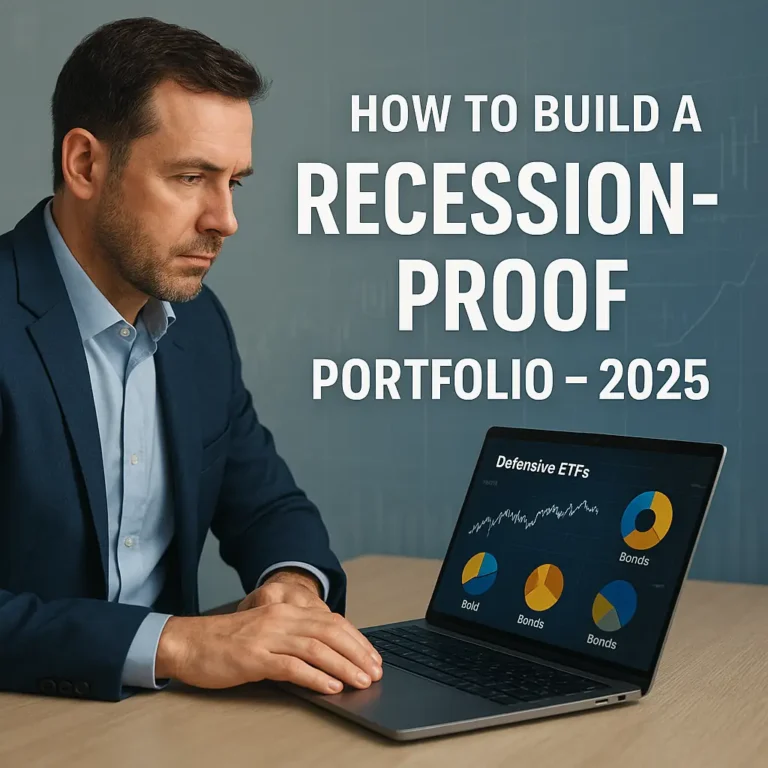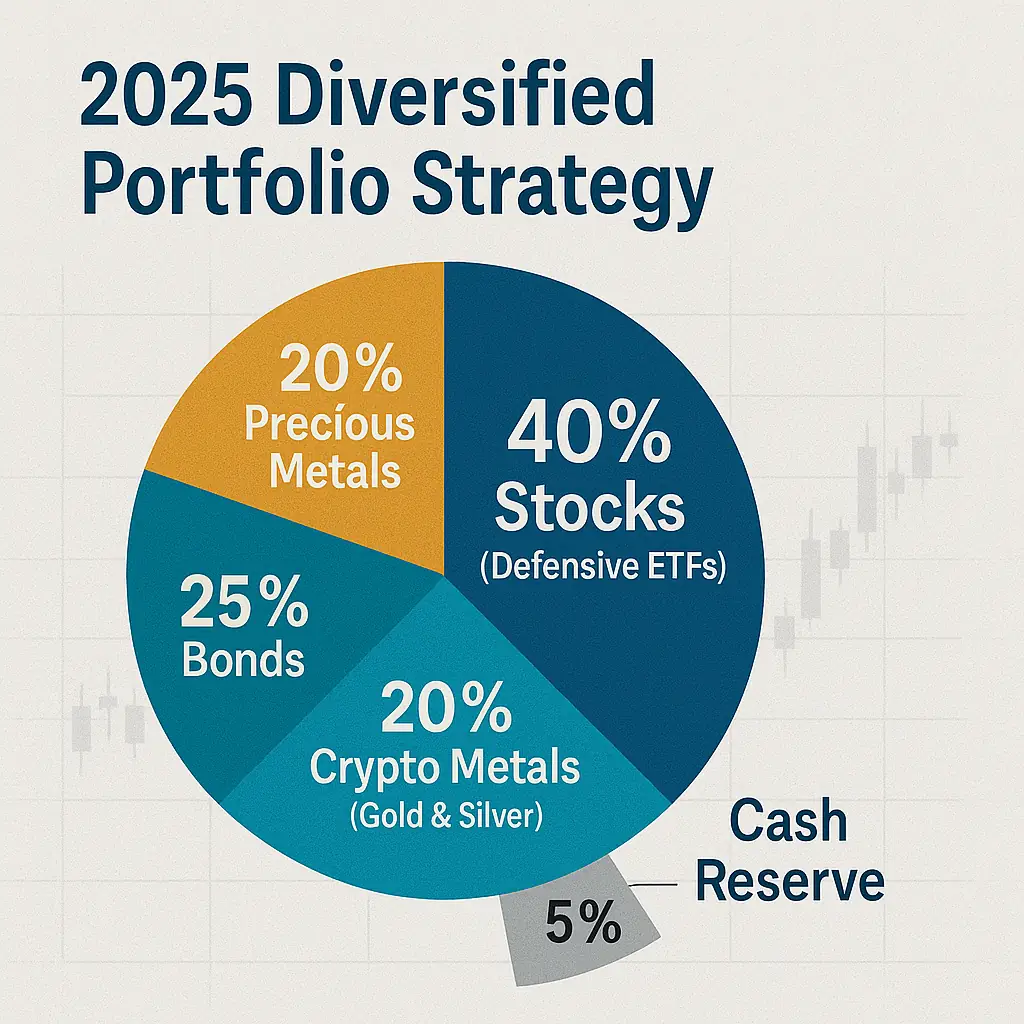
How to Build a Recession-Proof Portfolio Before the Next Downturn
If you want to build a recession proof portfolio before the next downturn, focus on resilience first and returns second. This simple, practical guide shows everyday investors how to combine defensive stocks and ETFs, precious metals, quality bonds, and cash buffers into a plan that can weather volatility without abandoning long-term growth. We’ll cover recession proof investments 2025, safe assets during recession, and a portfolio diversification strategy you can implement in hours—not months. Internal links point to deeper how-tos, and we’ll add live charts so you can see how core hedges like gold behave when risk rises.
📉 Key Points
- 🛡️ Prioritize defense: staples, utilities, healthcare, Treasuries, and gold cushion drawdowns.
- 📊 Blend growth with ballast: pair equity exposure with metals and high-quality bonds for stability.
- 🧰 Use ETFs for simplicity: defensive stocks and ETFs make diversification fast and low-maintenance.
- 💧 Keep liquidity: a 3–6 month cash reserve reduces forced selling during deep pullbacks.
- 🔁 Rebalance rules: harvest gains, refill hedges, and review allocations quarterly to stay on target.
Market Overview: Why 2025 Investors Are Seeking Safety
As inflation cools but growth slows in 2025, investors are increasingly searching for stability over speculation. Concerns about tightening credit, rising consumer debt, and geopolitical tensions have pushed many to build a recession proof portfolio that emphasizes safety and cash flow. The goal isn’t to predict a crash — it’s to protect your wealth if one comes. In this environment, defensive stocks and ETFs, along with gold and Treasury bonds, are reclaiming the spotlight as reliable safe havens.
A growing number of investors are shifting from high-beta growth stocks to low-volatility ETFs and inflation-hedging assets. According to CNBC, capital is steadily flowing toward defensive sectors such as consumer staples, utilities, and healthcare — all known for consistent earnings even when GDP contracts. Meanwhile, gold-backed ETFs like GLD continue to see increased inflows as traders look for an inflation hedge and volatility buffer.
The chart below shows how gold (GLD) has performed relative to the S&P 500 over the past year. Notice that even when equities dipped, gold often held steady — a reminder that diversification across uncorrelated assets can make a major difference when the economy slows.
How Investors Are Adjusting Their Strategies
In 2025, professional portfolio managers are rebalancing toward conservative positions — trimming speculative growth exposure and emphasizing sectors that historically outperform in downturns. As noted by Morningstar, utilities and consumer staples maintain strong demand regardless of economic conditions. They also tend to offer dividends, giving investors income even during stagnant markets.
At TradeStockAlerts.com, we’ve observed a similar trend among everyday traders — more users are blending tactical plays with defensive ETFs to balance volatility. Short-term profits remain possible, but wealth preservation has become the top priority for most investors heading into 2025’s uncertain landscape.
Next, we’ll break down the most dependable defensive stocks and ETFs to anchor your portfolio when the economy starts to wobble — and why these assets can provide consistency when others panic.
Defensive Stocks and Safe Assets That Outperform in Recessions
When building a recession proof portfolio, the first step is to focus on sectors that generate stable earnings no matter what the economy does. These are known as defensive sectors — industries like utilities, healthcare, and consumer staples that provide products people need even when budgets tighten. Defensive stocks and ETFs in these areas can act as shock absorbers during downturns, offering both income and relative stability.
For example, ETFs such as the Consumer Staples Select Sector SPDR (XLP) or Utilities Select Sector SPDR (XLU) often hold companies like Procter & Gamble, PepsiCo, and NextEra Energy — businesses that remain profitable through recessions. These funds typically pay reliable dividends, helping offset falling growth stock values when markets get rough.

Beyond equities, investors often add precious metals and government bonds for additional protection. Gold, silver, and Treasury ETFs act as natural hedges against inflation and market fear. During volatile periods, they tend to move independently from stocks — sometimes even rising while equities fall. According to Investopedia, mixing these “safe-haven” assets into a portfolio can reduce overall drawdowns and improve long-term returns.
If you prefer a diversified metals allocation, check out our Silver Rally Trading Strategy Signals guide, which explains how silver often follows gold but can outperform when industrial demand strengthens during late-cycle recoveries.
Safe Assets During a Recession
- 🏠 Consumer Staples: Companies like Procter & Gamble and Coca-Cola that provide essentials regardless of economic conditions.
- ⚡ Utilities: Stable demand for power and water keeps revenue consistent even when spending drops.
- 💊 Healthcare: Firms like Johnson & Johnson or Pfizer continue to see demand for medicines and services through downturns.
- 🥇 Gold & Silver: Physical metals and ETFs like GLD or SLV hedge inflation and uncertainty.
- 💵 Treasury Bonds: U.S. government debt remains a global safe haven that often rallies during stock sell-offs.
Incorporating these safe assets into your portfolio doesn’t mean giving up growth — it means building a stronger foundation for when markets inevitably contract. The next section explores how to combine these defensive holdings into a portfolio diversification strategy that can survive recessions while still capturing upside.
Portfolio Diversification Strategy: Balancing Risk and Stability
A true recession proof portfolio isn’t about owning one “magic” asset — it’s about diversification. By combining uncorrelated assets, investors can balance volatility while still participating in long-term growth. The goal is to build a mix that performs steadily in both expansions and recessions, keeping your wealth compounding even when markets get rough.
A classic approach involves blending equities, bonds, metals, and small allocations to alternative assets like crypto or real estate. While growth ETFs drive long-term returns, hedges such as gold, Treasuries, and cash protect the portfolio during shocks. This mix forms the core of what analysts call a multi-asset diversification strategy — the foundation of nearly every successful long-term portfolio.
Diversification doesn’t just reduce losses — it enhances performance consistency. During 2022–2023, investors who balanced growth ETFs with gold and bonds experienced smaller drawdowns and faster recoveries than those fully invested in tech. This same principle remains valid for 2025 and beyond.
Here’s a simple framework you can adapt to your own investment goals:
- 📈 40 % Equities: Core index funds or defensive ETFs that offer moderate growth potential.
- 💰 25 % Bonds: Treasury or high-quality corporate bonds to stabilize portfolio value.
- 🥇 20 % Precious Metals: Gold and silver ETFs that hedge inflation and market volatility.
- 🪙 10 % Crypto & Metals Blend: Diversified digital and industrial metal exposure for asymmetric upside.
- 💵 5 % Cash Reserve: Liquidity for buying opportunities during downturns.
For an in-depth look at how digital assets and metals can work together, visit our Diversified Crypto Metals Portfolio Guide, which shows how combining tangible and digital stores of value strengthens long-term stability.
This layered structure — defensive, growth, and hedge — helps ensure that when one segment weakens, another supports the portfolio. In the next section, we’ll explore key ETF risk management insights for 2025 and examine what analysts expect for the year ahead.
2025 Outlook: Positioning for Opportunity Amid Economic Slowdown
Even as talk of recession dominates headlines, 2025 offers opportunities for disciplined investors. The secret lies in understanding market cycles and preparing before volatility strikes. Building a recession proof portfolio doesn’t mean hiding from risk — it means structuring your investments so that downturns become temporary setbacks, not permanent losses.
Analysts from Reuters note that global GDP growth is expected to moderate in 2025 as central banks balance inflation control with economic support. In such conditions, defensive stocks and ETFs typically outperform, while gold and Treasury bonds often rise as investors seek shelter. The combination of these assets can turn fear into resilience — and volatility into long-term value.

Key Insights for 2025 Investors
- 📊 Recession-Proof Investments 2025: Focus on assets that generate cash flow — dividend stocks, REITs, and value ETFs.
- 🥇 Safe Assets During Recession: Keep exposure to gold and Treasury ETFs like GLD and TLT as hedges against drawdowns.
- 💼 Defensive Stocks and ETFs: Prioritize consumer staples, healthcare, and utilities for steady performance.
- 🌐 Global Diversification: International ETFs and emerging-market bonds can provide balance if the U.S. slows faster than other regions.
- 🧭 Portfolio Diversification Strategy: Review allocations quarterly and rebalance after major market moves to stay on track.
Experts at Forbes emphasize that preparation beats prediction. Nobody can call the exact start of a recession, but you can decide how your portfolio reacts when one arrives. By combining growth, income, and protection, investors can maintain confidence no matter how uncertain the headlines become.
For tactical traders, complementing long-term holdings with short-term setups — such as those highlighted in our Day Trading vs Swing Trading guide — can add flexibility and boost returns without exposing your entire portfolio to short-term swings.
Next, we’ll wrap up this guide with actionable FAQs and final steps you can follow today to secure your portfolio against the next market downturn — while still positioning for long-term wealth growth.
Frequently Asked Questions (FAQ)
❓ What does it mean to build a recession proof portfolio?
To build a recession proof portfolio means structuring your investments to remain stable when the economy weakens. It combines defensive stocks, safe-haven assets like gold, and diversified ETFs so that declines in one sector are offset by gains or stability in another. The goal is consistency — not prediction.
💼 What are the best safe assets during a recession?
Historically, U.S. Treasuries, gold, and defensive sector ETFs perform best when markets fall. These assets tend to hold value or appreciate as investors flee riskier holdings. Consider ETFs such as GLD, TLT, XLP, and XLU to hedge against equity volatility.
📈 Should I sell my growth stocks before a recession?
Not necessarily. Instead of selling outright, balance your portfolio by trimming high-volatility growth positions and reallocating some gains into defensive ETFs or bonds. This diversification cushions drawdowns while preserving long-term upside when markets recover.
🧭 How often should I rebalance a defensive portfolio?
Most investors rebalance quarterly or semi-annually. Rebalancing restores your target mix of stocks, bonds, and metals by selling assets that have grown overweight and buying those that have fallen behind. It’s one of the most effective risk management tools in volatile markets.
🌍 Is global diversification important in 2025?
Yes. Diversifying beyond U.S. markets reduces exposure to a single economy. International ETFs and emerging-market bonds can offer opportunities when domestic growth slows, improving overall portfolio resilience.
Final Thoughts: Protect Your Wealth Before the Next Downturn
The smartest investors don’t wait for a recession to react — they prepare in advance. By learning how to build a recession proof portfolio now, you can safeguard your wealth and even uncover opportunities that others miss. Defensive stocks and ETFs, precious metals, and well-timed diversification can make the difference between panic and profit during turbulent times.
As the global economy enters a slower phase, focus on what you can control: asset allocation, position sizing, and discipline. Keep your plan simple, balanced, and flexible. And remember — downturns don’t destroy wealth; lack of preparation does.
To see how metals and crypto diversification can complement a defensive portfolio, explore our Diversified Crypto Metals Portfolio Guide for step-by-step examples.

Pauline Lei
Market analyst and lead writer at TradeStockAlerts.com. Pauline’s market research focuses on defensive strategies, ETF diversification, and wealth protection during recessions. Her insights help everyday investors understand how to safeguard assets and seize smart opportunities through balanced, recession-ready portfolios.